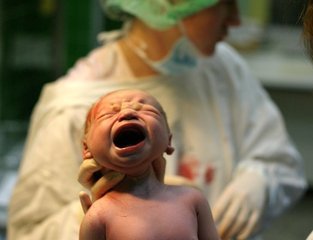Preterm labor
What is preterm labor?
Preterm labor is defined as regular contractions of the uterus that leads to change in the cervix that start before 37 weeks of pregnancy. Changes in the cervix include effacement and dilation.
What is preterm birth?

When birth occurs between 20 weeks and 37 weeks of pregnancy.
What is premature rupture of membranes?
- Rupture of membranes (PROM) that occur at term before onset of delivery
- Preterm PROM if occur less than 37 weeks
- Prolonged preterm PROM before viability (at < 24 wk)
- The interval between PROM and onset of spontaneous labor (latent period) and delivery varies inversely with gestational age.
- At term, more than 90% of women with PROM labor starts within 24 hours
- At 32 to 34 wk, mean latency period around 4 days.
Risk factors, which increase the incidence of preterm labor
- Infection
- Smoking or substance abuse during pregnancy
- History of PROM or preterm delivery in previous pregnancies
- Polyhydramnios: large volume of amniotic fluid
- Multiple gestation: being pregnant with two or more fetuses at one time
- Having had episodes of bleeding anytime during the pregnancy
- Amniocentesis
- Cervical incompetence: having a short or prematurely dilated cervix during pregnancy

Mechanism of rupture of membranes
Intrauterine infection is thought to be one cause of preterm premature rupture of the membranes (PPROM).
A prospective study of the vaginal flora in pregnancy shows that the presence of these vaginal floras increases the risk of premature rupture of membranes:
- Trichomonas virginals
- Bacteroides sp
- Ureaplasma urealyticum
What are the signs and symptoms of preterm labor?
- Change in character of vaginal discharge ( watery, mucus, or bloody )
- Increase in amount of discharge
- Pelvic or lower abdominal pressure
- Constant low, dull backache
- Abdominal cramps, with or without diarrhea
- Regular or frequent contractions or uterine tightening
Rupture of membranes and leakage of liquor
Diagnosis of premature rupture of membranes
- History : sudden gush of fluid or continued leakage of fluid
- Physical exam : check pooling of amniotic fluid
- Sterile speculum exam: The presence of amniotic fluid pooling in the posterior fornix of the vagina
- Dilatation of cervix
- Nitrazine paper for PH to distinguish amniotic fluid from urine and vaginal secretions. Amniotic fluid is alkaline so color will turn dark blue, vaginal secretions have a pH of 4.5 to 6.0, and urine has a pH of ≤6.0
- Using slides looking for ferning
- Avoid digital exam unless presence of labor
- Endocervical samples may be considered for gonorrhea and chlamydia testing if clinically indicated. Group B streptococcus cultures are obtained.
- Ultrasound : amniotic fluid index
Complication of premature rupture of membranes

- Chorioamnionitis: may occur it is a medical emergency. The mother will complain from fever, foul-smelling vaginal discharge, and abdominal pain.
- Abruption: premature separation of placenta
- Cord compression
- Preterm delivery & its complication
- Limbs deformity and lung hypoplasia
Differential diagnosis of premature rupture of membranes
- Urinary incontinence.
- Normal vaginal secretions of pregnancy
- Increased sweat or moisture around the perineum
- Increased cervical discharge: this can happen when there is a genital tract infection
- Semen
- Douching
- Vesicovaginal fistula: an abnormal connection between the bladder and the vagina
- Loss of the mucus plug
Management of preterm labor
- The main goal is to delay delivery as you can without doing risk to mother or fetus.
- Use tocolytic if no contraindications
- Corticosteroid
- Magnesium sulfate
- In utero transfer to tertiary center
Management of premature rupture of membranes
Corticosteroid: * Betamethasone 12 mg, 24 hours apart, in 2 doses.
* Dexamethasone 6 mg, 12 hours apart, in 4 doses.
Antibiotic: Antibiotic therapy has been shown to prolong pregnancy, but the effect on infant morbidity has been inconsistent.
Delivery
|
Fetal age |
Management |
|
|---|---|---|
|
Term &late preterm |
34-37 weeks |
|
|
Preterm |
24–33 weeks |
|
|
Pre-viable |
< 24 weeks |
|
Tocolytics
Tocolytic are medications used to suppress uterine contractions. They also buy time for the administration of corticosteroid to accelerate fetal lung maturity or to allow in utero transfer, but takes one to two days to work. Mother and fetus may require monitoring.
Contraindication to tocolytics
- Gestational age more than 34 weeks gestation
- Fetus weighs less than 2500 grams or has intrauterine growth restriction
- Placental insufficiency
- Lethal congenital or chromosomal abnormalities
- Advanced cervical changes , dilatation is greater than 4 centimeters
- Chorioamnionitis
- Mother has cardiac disease , pre-eclampsia
- Fetal distress or fetal death
What is magnesium sulfate?
Magnesium sulfate is a medication that may be given at gestational age less than 32 weeks, and are at risk of delivery within the next 24 hours.
It has a neuroprotection, reduce the risk of cerebral palsy that is associated with early preterm birth.
What are corticosteroids?
Betamethasone and dexamethasone are corticosteroids, that are given before birth to accelerate a preterm fetus's lung development, used when a mother is in preterm labor to prevent respiratory distress syndrome (RDS) and complications of premature birth after delivery.
Antenatal steroids can decrease rates of:
- Breathing problems (respiratory distress syndrome) after birth.
- Bleeding in the brain (intraventricular hemorrhage).
- Intestinal infection (necrotizing enterocolitis).
- Death.
Types of corticosteroids?
If there is a possibility that you may have preterm delivery two types of Corticosteroids can be given to you to help your baby. Corticosteroids are given by an injection into the muscle.
Betamethasone and dexamethasone enhance fetal lungs to produce surfactant, so babies are more able to breathe on their own, or with less treatment with surfactant, after birth.
Dexamethasone is recommended over betamethasone based on its efficacy, safety, wide availability, and low cost. Betamethasone, on the other hand, is preferred over dexamethasone due to better prophylaxis against brain softening of premature fetus.
Treatment consists of 12 mg of betamethasone 2 doses given 24 hours apart or 6 mg of dexamethasone 4 doses given 12 hours apart.
At what stage of pregnancy should corticosteroids be given?
A single course of corticosteroids offered to women between 24 and 34 weeks and 6 days of gestation who are at risk of preterm birth. In the case of elective caesarean section between 35 and 38 weeks and 6 days, corticosteroids are recommended, to reduce respiratory morbidity. If delivery does not occur within 7 days of treatment, the injections should not be repeated, as this May cause long-term effects on the growing child.
How long are they effective for?
Corticosteroids are most effective if the last dose is given between 24 hours and 1 week before delivery.
Corticosteroid can reduce neonatal death within the first 24 hours so can be given within this time.
Side Effects of Corticosteroid
Corticosteroid can cause fluid retention and increased blood pressure. But these are short-term and less likely to occur at all during such a short period of treatment.
Control of diabetes may be more difficult in pregnant women when corticosteroids are used. Your doctor may recommend a different insulin dose during this time.
Who should be given corticosteroids in pregnancy?
- Premature labor
- Premature rupture of membranes
- Intrauterine growth restriction
- antepartum hemorrhage
Caution should be taken when giving corticosteroid therapy to women with systemic infection tuberculosis or sepsis.
Dr Najeeb Layyous F.R.C.O.G
Consultant Obstetrician, Gynecologist and Infertility Specialist







 Pregnancy Due Date Calculator
Pregnancy Due Date Calculator
 Chinese Gender Predictor
Chinese Gender Predictor
 Ovulation Calculator
Ovulation Calculator
 IVF Due Date Calculator
IVF Due Date Calculator
